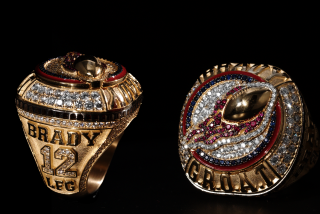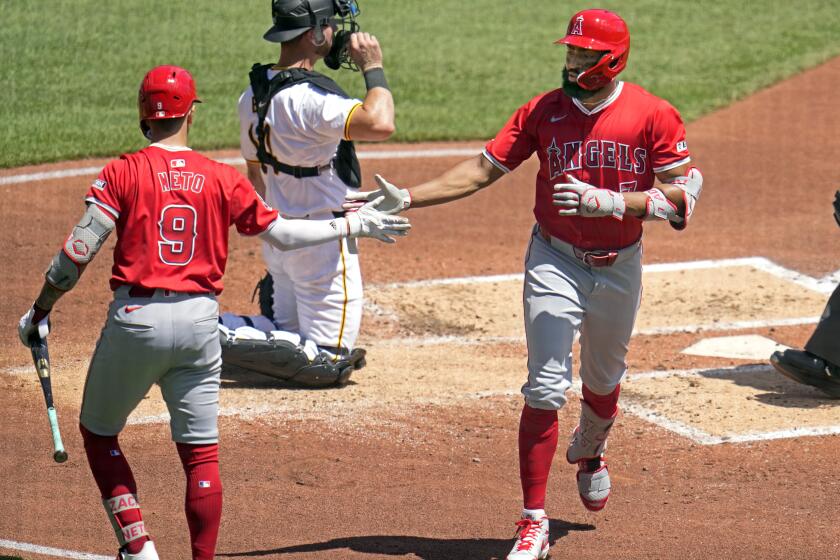Working the Other Side of the Track : Del Mar’s Gates Open Wednesday. Here, a Tale From the Inside.
MISS DANIELA WAS READY, Eddie Crandell confided to me when I ran into him near the Del Mar saddling paddock before the first race. Crandell’s a “hot walker,” for the moment at least, and he and a groom had walked the big filly the long way from her stall over in J barn on the backside all the way to here. The assistant trainer, Ricky Sanchez, was putting her saddle and racing bridle on right now in the paddock’s No. 3 stall. Crandell still held the leather and chain shank he’d used to bring Miss Daniela over. “Everybody’s betting,” he said in that supremely confident race-tracker tone--the sun will rise and Miss Daniela, a mediocre 3-year-old with a bad disposition, will win.
“Everybody?”
“Everybody.”
“I don’t know,” I said neutrally, hovering as I was in that familiar limbo between belief and disbelief, wanting to believe, but--I looked up at the odds board just above the paddock. She was 11 to one. I looked at the program and saw that Miss Daniela was being ridden by Fabian Valenzuela, the younger brother of Patrick Valenzuela, the meet’s top rider. Poor Fabian--the kid brother hadn’t had many chances. He seemed to have no confidence. I looked doubtfully at Crandell. This one I wouldn’t buy.
Crandell, dapper in the nylon jacket, the good khaki pants, the blue jogging shoes, was not fazed by my disbelief. He’s been many places, done different things (for several years he sold used cars on Oahu, some rustier than others) but the race track was his home. The ability to believe again was the one essential requirement in this world, and the can’t-lose 2-year-old he’d given me the day before (she lost) was gone from memory. “If I bet her she’ll lose,” I said.
“That’s bull,” Eddie said and then pushed off into the crowd flowing in leisurely through the gates that afternoon.
“You really ought to do yourself a favor,” he said over his shoulder. “This one’s a lock. Really.”
It was the final day of Del Mar’s all-too-brief 43-day summer meet, which has a way of passing like a single sunny weekend beach party, part resort-town diversion, part serious race track, but not too serious. “The Saratoga of the West.” Good old Del Mar. Soon enough a 40-year-old record made by a man now 10 years dead floated its familiar benediction out over the gathering faithful, as it will again when this year’s meet opens Wednesday: “Where the turf meets the surf down at old Del Mar . . . take a plane, take a train, take a car,” sang the electronically preserved voice of Bing Crosby.
Where would Southern California be without its show business gods? The road around the track is Jimmy Durante Boulevard, and here and there--in the infield tunnel for instance--were bright pastel murals featuring the images of Bing Crosby and Pat O’Brien, Del Mar’s co-founders, although clearly it was Crosby’s spirit that still ruled.
The magic remained potent. Up and down the concrete apron in front of the grandstand, blankets claimed tiny picnic areas as if this were the beach. The young crowd sat in aluminum lawn chairs, Racing Forms spread before them as the horses for the first race paraded by and Crosby--or his recorded voice--finished the song: “There’s a smile on every face and a winner in each race. . . .”
Certainly a winner in each race.
As for myself, I had taken a seat in the south end of the grandstand, feeling relaxed and pleased with myself. Two days before, I had left a six-week job on the backside (that opposite world you glimpse from the stands that lies across the infield, back there), and I was mulling what it was exactly that I had learned. What did I know? Could I separate good inside information from bad? Had I learned that much? I looked at the tote board. Miss Daniela was up 13 to one.
I’D MET CRANDELL FOR THE first time a month before. I was sitting in the backstretch “kitchen” with an early morning cup of coffee and Crandell stopped at my table.
“I saw you walking horses for John Sadler,” he said.
Crandell was in his mid-50s, a little round-shouldered and tubby, with short gray hair and clever eyes that tended to roam the cafeteria even as he spoke to me. I admitted I worked for Sadler, and Crandell sat down and pumped me for information. He was thinking of going to work for Sadler’s busy 30-horse stable and wanted to know about pay and conditions, and then the all-important question: “Does he make you come back in the afternoons?”
“No.”
There was something of the Eastern wise guy in Crandell’s voice, New York maybe. He reminded me of the comic actor, Jack Weston. Even at rest his face had a faint knowing grin. Angles, finding the edge, were clearly this man’s business. He’d been walking horses for a small trainer who’d stiffed him on his last few weeks’ salary. Crandell was ready for a change and, sure enough, arrived at Sadler’s barn the next morning at 5:30. He wore his blue jogging shoes and was a welcome addition to our little club, a cheerful font of Vegas-style one-liners (“I’m so broke I can’t even pay attention” and its cousin, “I’m living on the interest to my debts,” were two of his favorites.)
There were between four and seven of us walking, depending on who showed up that day, who quit, who got fired for fighting or telling the boss how to train his horses (everyone at the race track knows more than everyone else). Mostly what we did was lead horses around and around, 20 minutes to an hour each after their workouts, cooling them out or just giving the non-workers a little exercise. This was done on a “tow ring,” a 60-foot oval patch worn into the soft, sandy stable dirt.
“This remind you of ‘Bridge on the River Kwai,’ ” Crandell would ask and hum a little of the “Colonel Bogey March.” There was something slightly penitential about the work, especially when the sun broke through the Del Mar seaside overcast around 10. People were prone to get quiet under the broiling sun and to stare at the ground. My problem was different. There was so much going on in a stable as big as Sadler’s, a constant parade of horses coming and going, anxious owners, minor jockeys sniffing around for a mount, busy vets poking at hoofs and putting tubes down noses--there was a lot to see, a lot of conversations to try to overhear, and it is quite possible to forget you have a dangerous animal in hand. (I’d come to think of racehorses as huge, slightly prehistoric mental patients who had to be watched every second.) Before I’d know it I’d be tailgating the horse in front of me and Crandell or another of the hot walkers would be screaming at me: “Damn it, you’re too close! One of these days you’re going to get a steel shoe in your face.” They were right, I was the greenest of the green and had a lot to learn.
The stables of any modern race track are essentially strange, it seems to me, not quite of this time in some basic way. “It’s a different world back there,” the front-side people usually say, but what they feel about that world usually doesn’t go much further unless they toss in the word sanctuary : “It’s a kind of sanctuary, you know.” But what is it exactly that is threatened “back there,” behind the gates, what fragile thing is it that is hiding in this sanctuary?
In August of 1985, the Immigration and Naturalization Service invaded the Del Mar stables just before dawn, the time an army attacks to catch an enemy off guard. One thing that happened was that more than 100 illegal aliens, the bulk of the backstretch labor force, were collected into buses and carted off. Another thing that happened was that an immigration officer drove right out onto the track, nearly causing a horse to throw jockey Bill Shoemaker, the racing world’s one living legend. Many witnesses to that strange morning nearly weight the two things equally. It was as though the king had been insulted and the empire was now in doubt.
The story intrigued me, the way it flashed across the front pages and then vanished. What had happened afterward? I knew that one day of racing had been canceled, but then it seemed to be business as usual. Was this true?
When I arrived at the beginning of last summer’s meet, the crises did in fact seem to have vanished, and most of the illegals had slipped back in by one method or another. Some trainers found they could get their stable workers under an obscure “sheepherder” quota buried in the immigration law. Others just came back through a hole in the fence. The raid had been showy, but in its wake, little had really changed.
Not everyone approved of the Latino dominance of work on the backstretch. Here and there you could find “American firsters,” but mostly the reverse was true.
“Americans don’t usually work out back here,” a sour-faced trainer said to me when I presented myself for employment. He looked at me like a man confronted with a huge spider realizing he had forgotten his can of Raid. “You know what the first thing an American asks?” he asked. “ ‘What’s my day off?’ And the second question is, ‘What time’s the coffee break?’ ”
Outside the race-track gates the late 20th Century whips by on Interstate 5, and $500,000 condos, round and white and slightly Arabic, climb the surrounding hills, but inside, down here in the dirt, it is an earlier century. There are moments when you get flashes of the Old California of ranchos and indentured labor. The trainers ride high above you on their stable ponys, coming to and from workouts, and now and then you hear someone call one of them “ patrone .”
It’s a migrant gypsy camp in which some 600 or 700 men and women live side by side with 2,000 horses. The 12x12-foot wooden “sweatboxes” and cement-floored tack rooms have no official existence as living quarters but each year, as if for the first
time--it’s only temporary after all--the little cells are made into small apartments.
One is lucky to get them. No one complains.
AFTER WORKING A WHILE IT occurred to me that the horse and I were on equal footing. We were each others’ keepers and tormentors, each dependent on and confined by the other. One of them lived in a stall on the other side of the wall of the tack room where I bunked. Every night he’d wake me up three or four times with his snorting and snuffling, muttering to himself like an old man. I’d bang the wall. It did no good.
Once around 2 in the morning I went out to hoof it over to the restroom. It was very quiet in the yellow glow of the all-night stable lights. Horses were nodding off on their feet, others flaked out on the ground. Suddenly a big black horse in one of the steel mesh pens went berserk, kicking and bucking and wheeling around, giving me that lunatic horse look--eyes popping, showing plenty of white around the irises. I thought he’d hurt himself and was toying with the idea of letting him out when just as suddenly he subsided, puffing and blowing and staring at me as if to say: “Next time, jerk, I’m breaking out of here.”
God knew what a horse thought. Jockey Eddie Delahoussaye, one of the top riders at the meet (and in the country, for that matter) one morning stopped at Sadler’s stable to stroke the rubbery, whiskered muzzle of a horse he’d recently ridden. “I bet he thinks you’re the enemy,” I said.
“No, I don’t think so,” he said. “The horse likes what he does. It’s what he’s trained to do. He’d probably do it by himself if we let him.”
I liked that image--of all the horses sneaking out to put on their own races.
“Does he remember you?” I asked.
“He knows his groom, not me,” Delahoussaye said without regret. There is a noticeable lack of sentimentality among many race trackers. “I like good horses with real ability,” trainers will say if you ask them if they like horses.
The horses are demanding wards (“They don’t care what day it is, they still have to eat”) and Sadler’s stable help worked every day with no day off, each day comfortably similar to the one before. The easygoing hot walkers drifted in around 5:30 in the morning and were out by 11. The grooms were already hard at it when we arrived and would work until lunchtime and come back for part of the afternoon as well. They made twice the money we did and earned it--feeding and washing the large, often disagreeable animals, tending their many ailments and injuries and doing the muscle work as well, mucking out the stalls. It was the kind of sweaty, exhausting and sometimes dangerous labor that most cable-ready, mid-’80s Americans have gratefully left behind.
The race-track product itself, though, still has appeal, and each afternoon Del Mar’s sporty young crowd rushed into the grandstand, dressed for the beach, toting foam ice chests and aluminum chairs. By 7 the spectacle was over, they were gone, probably a little poorer, often a little drunk. Then a man in goggles driving a speedy little scoop-nosed tractor would make his expert spins up and down the cement apron of the deserted grandstand, pushing broken lawn chairs and mounds of programs and Racing Forms and bottles into great mountains of refuse stinking of beer.
There were those, meanwhile, on the backside who watched all of this across the infield with a certain detachment. These were the illegals who still held many backstretch jobs and lacked the license to go to the other side, as if even here, 40 miles into the United States, they were still on the wrong side of the border.
On the backside, emotional Mexican ballads still had an edge over gringo pop, and at night between the tiny sweatboxes where many lived, barbecues were held. Cats played hide and seek in the barn hay; dogs brooded in the dirt. It could have been someplace in Chihuahua or even Central or South America.
I talked to a Mexican groom named Tony Gonzales about the life one morning. I knew Gonzales to be one of the most thoughtful and conscientious of grooms and thought he might have something illuminating to say about this life. But there really wasn’t much to say. “In my hometown not even the lawyers make as much as I do,” he said. “I never believed in my whole life I’d make so much.”
He was 22, from a family of eight in Guadalajara. He had been with Sadler four years and hadn’t been home in that period but hoped to go one day.
A few of the grooms--not many--had wives and girlfriends. There were, he said, two prostitutes working the Del Mar backstretch. One was Guatemalan, one American. They charged $20 a throw.
One night around 8 I saw Tony leaning against one of the little sweatboxes, hands behind his back in the classic watching-all-the-girls-go-by posture.
“Waiting for someone?” I asked.
Tony was one of those rare people who seemed incapable of telling a lie. “No,” he said. “I just didn’t have anything else to do.”
There was a fair amount of just hanging around back there among the live-ins (as opposed to the more affluent owners and trainers and jockesys, who could commute to condos and hotel rooms in panther-like muscle cars so popular around the track). The live-ins tended to be a mellow bunch, though I heard of a few fights (Rocky, a hot walker, got after a thief with a pitchfork after the loss of his second stereo). People drank a lot of beer. Some of them rigged up TVs in their tack-room digs. Some, mostly women, did remarkable things with those cement-floored little cells, adding rugs and pictures--of winning horses mostly. Life went on in an approximation of normal. A lot of people had dogs and you’d see them walking them around the barns at night, as if they were in just another small American town. There was in fact a strong sense of peacefulness and security back there, and this wasn’t just because of the hourly security patrols that went on through the night. Mostly the peacefulness came from a sense of shared fate, shared hardship, I think, as if we were all part of some obscure army unit forever moving from base to base, track to track. There was friendliness about backsiders, as if a dirty and often dangerous life had somehow blessed them. Strangers did not look away as you approached. “Hey, how’s it going?” they would ask. I always felt better getting back inside the gates after a trip outside.
The language babble around the stable was a constant Spanish-English stew and a lot went right over my head. I did not know, for instance, of a feud brewing between a Puerto Rican hot walker named Steve and Julian, a Salvadoran groom. Julian had made fun of Steve’s Puerto Rican Spanish. Steve was an intense young man with a thin smudge of a mustache and something of a chip on his shoulder. He brooded on the insult and finally retaliated by turning Julian--an illegal--in to the stable guards.
When trainer John Sadler heard about this he immediately fired Steve. I heard the exchange. “I’m sorry. You’ll have to leave. We just don’t want you around here.”
Steve protested.
“We have nothing more to talk about,” Sadler said.
Sadler is a polished, college-educated (University of Oregon) new-breed trainer, the son of a retired Pasadena stockbroker who nevertheless come up through the race-track ranks and at 30 was blessed with Melair, one of the nation’s top 3-year-old fillies, in his barn, and as many horses to train as he could handle. He did a lot of the work in the approved patrone style--on the back of the stable pony--issuing orders through his capable lieutenant, Ricky Sanchez. But Sadler took care of the Steve-Julian thing personally.
I asked him about it later. “He could have done almost anything else, but not that,” he said. That? Finked. Broke the code.
Actually, it wasn’t as serious as it seemed. As an old stable hand commented to me one day, “You can’t really fire anybody on the backside.” What this meant was that while you could be fired, it didn’t really matter much. There was always another job just down shed row. Steve felt like pouting for a few days and did so and after that went to work for a different trainer a few barns over. The guards came looking for Julian but couldn’t find him, and as far as I know they didn’t press the matter. They’d gone through the motions; they’d tried.
Owners were the ones I felt sorry for. Usually they seemed a little uncomfortable coming to visit the animal who’d carry their colors in the afternoon. In the morning all the horses wore the blue-and-tan saddle cloths of the Sadler stable; in the morning the horses were Sadler’s. Owners, well-dressed and without function here (“The only thing an owner is good for is to pay bills” is a backside axiom), often seemed in the way.
THE FORTUNES OF OSCAR, a Colombian groom, and Marlene, a cheap, Mexican-bred, 3-year-old filly, were briefly linked with my own. Oscar, 54, a family man and devoted reader of the Spanish edition of Reader’s Digest, groomed three of Sadler’s horses several barns away from the rest of the overflowing stable. Oscar felt exiled over there and complained constantly. Marlene merely added insult to injury. She was a pretty bay, tiny for a racehorse and exceptionally good-natured. She was also a “cribber,” the horse equivalent of smoking cigarettes or taking snuff. After an alfalfa snack Marlene was prone to take the strap that ran across her staff in her teeth and bring up a big belch. “Urrrp,” she would say with what I imagined to be a defiant gleam in her eye.
“She sucks air,” Oscar said disdainfully. “Horses that do that are no good.”
Besides being exiled, Oscar was forced to put up with a defective like Marlene. I liked Marlene right away. Mostly I suppose this was because of her non-threatening disposition. Horses, it had been explained to me, are very closely attuned to their “fight or flight” reflexes, and as big as they are they seemed anxious about everything. (Right in the middle of his bath, a 2-year-old colt had “gone up” on me, eyes wild with terror, and before I knew it he had struck at me with his killer hoofs, missing by inches. Then he pulled away from me and went careening off through the stables, leaving me shaken and completely in the dark as to what had spooked him. He was green, they told me, just in from the ranch. But what scared him, no one knew.) Marlene, as small as she was, didn’t seem to have a worry in the world.
I got very fond of Marlene, too fond for my own good. We were both outsiders and her cause became my own. “Never get too high on a horse,” one of my fellow hot walkers warned me. “They will just let you down.” But I got very high on Marlene and became strangely convinced that when I talked to her she listened and understood. (It did not help that the grudgingly affectionate look I imagined in Marlene’s long-lashed eyes was exactly like that of a woman I once liked.) “You may be little but you’re fast, a winner, the best,” I told her. She nodded, she heard. She went off at 20 to one when she finally ran and came in a wheezing ninth. I had made my biggest bet of the meet on her; I had, in effect, become the victim of my own self-generated inside information, based, when you finally sort it out, on Marlene’s good nature and the fact that, unlike her larger, clumsier colleagues, she had never once stepped on my foot. Some tip.
Then, on the last day of the meet, when I had reverted to civilian status and Eddie Crandell told me about Miss Daniela, in the first, I had no ears to hear. Fabian Valenzuela riding? She was even owned by Marlene’s owner and in my book had no shot. Miss Daniela won by a length and a quarter and paid $28.40.
I had to laugh.
More to Read
Get our high school sports newsletter
Prep Rally is devoted to the SoCal high school sports experience, bringing you scores, stories and a behind-the-scenes look at what makes prep sports so popular.
You may occasionally receive promotional content from the Los Angeles Times.






